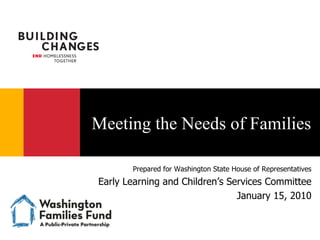Washington Families Fund Presentation to Early Learning And Childrens Services Committee 1-15-10
- 1. Meeting the Needs of Families Prepared for Washington State House of Representatives Early Learning and ChildrenŌĆÖs Services Committee January 15, 2010
- 3. Building Changes Core Strategies
- 4. Building Changes Grantmaking Washington Families Fund ŌĆō Authorized by Washington State Legislature in 2004 A public-private partnership that expands the availability of supportive housing for families in need by providing stable, long-term funding to agencies with the best models for ending family homelessness and strengthening communities throughout Washington State.
- 5. Washington Families Fund A Public-Private Partnership ŌĆó Funding partners: 23 ŌĆó Fund total: $26 million ŌĆó Awards-to-date: $15.8 million ŌĆó Counties: 15 ŌĆó Nonprofit programs statewide: 43 ŌĆó Service-enriched housing units: 618 ŌĆó Families supported: 1,009
- 6. WFF Funded Programs by DSHS Region $4,072,130 163 units $1,032,195 47 units $4,448,877 152 units $2,109,290 126 units $2,864,185 $1,225,000 95 units 35 units
- 7. Washington Families Fund Primary Goals for Families ŌĆó Greater housing stability, including a transition to permanent housing upon program completion ŌĆó Improved economic and educational advancement ŌĆó Increased access to and use of needed community based services and support ŌĆó Greater likelihood of family stability including re- unification and increased stability in childcare and school attendance
- 8. Washington Families Fund Family Outcomes to Date Who Are The Families Served and Are We Meeting Their Needs?
- 9. Moderate-Needs Families ŌĆō Profile Typical parent is: ŌĆó Female (92%) ŌĆó Average Age 31 years ŌĆó Average of 2 children ŌĆó HS Diploma or greater (66%) ŌĆó First time Homeless (60.74%) ŌĆó Experienced DV (66%) ŌĆó Disabling Condition (34%) ŌĆó TANF Recipient (66%) ŌĆó Working (24%)
- 10. Moderate-Needs Families ŌĆō Overview (Five Year Data) ŌĆó Total families served: 940 ŌĆó Adults: 1,103 ŌĆó Children:1,755 ŌĆó Families exited housing: 491 ŌĆó Average length of stay: 11.4 months
- 11. Moderate-Needs Families ŌĆō Housing (Five Year Data) Majority of Families Secure a Permanent Home After Completing a WFF Program 73% 80% 60% 40% 20% 9% 6% 6% 6% 0% Permanent Living with Transitional Homeless Other Housing Family/Friends Housing Situation
- 12. Moderate-Needs Families ŌĆō Sources of Income (Five Year Data) Increase in Economic Stability Intake Exit % Change TANF 68% 55% -13 Employment 24% 36% 12 SSI/SSDI 9% 12% 3
- 13. Moderate-Needs Families ŌĆō Monthly Income (Five Year Data) Majority of Families Increase Monthly Income; Yet Remain Far Below Self-Sufficiency Standard $3,300 $3,500 $3,000 $2,500 $2,000 $1,249 $1,500 $987 $1,000 $500 $- Intake Exit Self Sufficiency
- 14. Moderate-Needs Families ŌĆō School Stability (Five Year Data) School Stability Improves with Housing Stability ŌĆó School age children attended 2 schools, on average, in the last year ŌĆó With housing stability: 80% increase in the number of children remaining in the same school
- 15. Moderate-Needs Families ŌĆō Programs Helping Hand House: Rural Bright Futures Case management and support services in rural Pierce County. Consejo Counseling and Referral Service: Villa Esperanza Case management, health services and legal advocacy services for Latino families who are homeless due to domestic violence in South King County. Transitions: Spokane Family Futures An innovative collaboration between four organizations to provide support services in conjunction with Section 8 vouchers.
- 16. Washington Families Fund Making Progress ’ā╝Housing Stability ’ā╝Increased Income ’ā╝School Stability
- 17. Washington Families Fund Meeting Challenges ŌĆó Affordable market rate housing ŌĆó About a quarter of families exit program without stable housing
- 18. Washington Families Fund Creating Solutions High-Needs Family Service Model ŌĆó Developed a screening tool to better identify needs and target families with multiple barriers ŌĆó Fund programs targeting families with greater needs ’é¦ mental health ’é¦ substance abuse ’é¦ domestic violence and trauma ’é¦ children living away from home
- 19. High-Needs Families ŌĆō Programs Volunteers of America: Housing First ŌĆō Sky Valley Case management, dedicated drug, alcohol, and mental health treatment, access to basic medical and dental care, and life skills training in Snohomish County. Abused Deaf WomenŌĆÖs Advocacy Services: A Place of Our Own Intensive case management and wrap-around supportive services in Seattle to chronically homeless Deaf and Deaf-Blind adults and their children who are also victims of domestic violence.
- 20. High-Needs Families ŌĆō Initial Findings (Baseline Data) ŌĆó Initial baseline assessment data on 57 High-Needs Families; composed of 66 adults, 88 children and an additional 35 children living away from the household ŌĆó Initial findings reveal that 85% of parents have substantial housing barriers and service needs
- 21. High-Needs Families ŌĆō Profile Typical parent is: ŌĆó Female (86%) ŌĆó Average Age 33 years ŌĆó Average of 2.4 children ŌĆó Has a child living away (42.1%) ŌĆó HS Diploma or greater (52%) ŌĆó Homeless > 3 times (51%) ŌĆó Experienced Violence (93%) ŌĆó Disabling Condition (68%) ŌĆó TANF Recipient (63%) ŌĆó Working (12%)
- 22. High-Needs Families ŌĆō Barriers to Housing (Baseline Data) Emerging Profile of Chronically Homeless Families Average number of times homeless in lifetime 9.9 At least one child living apart 42% Open Child Protective Services (CPS) plan 25% Experience of physical or sexual violence 93% Chronic or ongoing medical problem 68%
- 23. Washington Families Fund Looking Ahead ŌĆó The Right Services to Families at the Right Time ŌĆó Breaking the Cycle of Homelessness ŌĆó Three-county Pilot Program
- 24. Washington Families Fund Making Progress ŌĆó Most families are stably housed with rising employment and incomes; children are stable in schools ŌĆó Identifying and working on solutions to address chronic family homelessness ŌĆó Supporting systems change through pilots in three counties
























